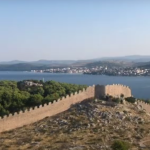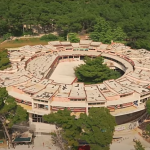Croatian Etiquette
Followers of Total Hvar can be forgiven for thinking that the most common form of address on the island is ‘Eh –ee’, sounding like a drawn-out but crisp ‘a’ in English, and probably spelt ‘Ei’ in Croatian. Indeed, it probably is the most used greeting around the Total Hvar headquarters at Café Splendid in Jelsa.
‘Eis’ bounce back and forth in profusion, especially when Professor Frank John Duboković, keeper of the Hvar dialects, is holding court and acknowledging his multitude of friends, relatives, acquaintances and associates with his now world-famous rendition of it. The ‘ei’ stands alongside high-fives, fist-touching, and other exuberant forms of saying ‘hello friend’.
However, it is not a greeting for strangers or formal occasions like visiting your bank manager, going for a job interview or meeting the prospective in-laws. The correct forms go as follows:
1. At the very beginning of the day, it’s ‘Dobro jutro’ – ‘Good morning’.
2. Later, it’s ‘Dobar dan’ – ‘Good day’. When does ‘dobro jutro’ become ‘dobar dan’? That’s not easy to say, but it seems to be somewhere between 8 and 9 am. ‘Dobro jutro’ certainly doesn’t extend across the whole morning to noon, as it might in the UK.
3. ‘Goodbye’ is properly ‘Doviđenja’.
4. The latter part of the day takes on ‘Dobra večer’ – ‘Good evening’. Again, it assumes its place later in the day than in the UK, possibly at the point when dusk is falling.
5. The final greeting is ‘Laku noć’ – ‘Good night’, which is often expressed as ‘Dobra noć’ on the island.
There are of course more familiar greetings, such as ‘zdravo’ = ‘hello’ or ‘hi’. The ubiquitous ‘bog’ serves the same function, and can also be ‘goodbye’, as a short form of ‘zbogom’ (= ‘Go with God’, the same idea as in ‘goodbye’). On Hvar, people very often say ‘Zdravi bili’ for ‘hello’, which translates roughly as ‘Good health to you’, and the response is ‘i veseli’, (‘and happy’ or ‘and merry’ according to your state of frivolity). After the greeting, people commonly ask ‘How are you?’ – ‘Kako ste’ (or ‘kako si?’ if you are on familiar terms). A standard and safe response is ‘Dobro, hvala, a Vi?’ – ‘I’m well thank you, and you?’
However, this might elicit a lengthy outpouring of aches, pains, undesirable illnesses and/or bereavements: the gist is usually clear, even if you don’t understand the words, so you’re probably safe just looking sympathetic, or interjecting ‘Žao mi je’ – ‘I am sorry’ – at intervals if you feel confident enough. If all else fails, you may have to give up the pretence: ‘Ispričavam se, ne razumijem’ (= ‘I’m sorry, I don’t understand’) should call a halt to the litany.
As an alternative to ‘Kako si?’, friends often ask ‘Di si?’ after the first greeting. This means ‘Where are you?’ literally, but, especially when the speakers are face to face, it is used in the sense of ‘How are you?’, ‘Where have you been?’, ‘Glad to hear from you’ and a host of other friendly bits of badinage. If you have to press past someone from behind in the street, the way to ask him or her to stand aside is ‘Samo malo’ (which means ‘just a little’ if translated literally). Be warned that if you fail to respond to a murmured ‘samo malo’, you’re likely to get elbowed out of the way.
The word for ‘please’ is ‘molim’. ‘Hvala’ means ‘thank you’, and the usual answer is ‘nema na čemu’, the equivalent of ‘you’re welcome’, roughly translating as ‘think nothing of it’. Another response is ‘i drugi put’, which can be translated as ‘any time’. Using ‘molim’ and ‘hvala’ is always appreciated.
Then there’s the dilemma about how to address people correctly. The politest form is to use the terms Gospodine, Gospođo or Gospođico (alternatively Gospodično) followed by the surname or sometimes the title, meaning Mr., Mrs., or Miss. So you might say ‘Gospođo Tomić’ = Mrs. Tomić or ‘Gospodine Predsjedniče’ = Mr. President. These are vocative forms, the style you use when you are talking to someone directly.
Slightly less formally, you can use these terms without the surname, and when you are on more familiar terms, you can use them followed by the person’s Christian name. On the island, it is common for older people to be known as ‘Barba’ (=uncle’) or ‘Teta’ (=aunt), usually followed by their Christian name. Sometimes the terms ‘Nono’ (= ‘grandfather’), or ‘Nona’ or ‘Baka’ (= ‘grandmother’) are used instead, although the logic of this is not always clear.
These are terms of respect, and formal boundaries still rule in Croatian society. Within families, the in-laws are usually addressed as ‘Barba’ or ‘Teta’, and it is rare for the younger generation ever to get to use the in-laws’ Christian names. In no circumstances is it acceptable to progress from the formal ‘Vi’ = ‘you’ to the informal ‘Ti’ without a clear invitation from the older person.
Social rules in Croatia differ in detail from those elsewhere, but as everywhere in the world, good manners, courtesy and consideration for others go a long way to creating harmonious relationships, regardless of language barriers.
Language and Numbers
Followers of Total Hvar can be forgiven for thinking that the most common form of address on the island is ‘Eh –ee’, sounding like a drawn-out but crisp ‘a’ in English, and probably spelt ‘Ei’ in Croatian. Indeed, it probably is the most used greeting around the Total Hvar headquarters at Café Splendid in Jelsa.
‘Eis’ bounce back and forth in profusion, especially when Professor Frank John Duboković, keeper of the Hvar dialects, is holding court and acknowledging his multitude of friends, relatives, acquaintances and associates with his now world-famous rendition of it. The ‘ei’ stands alongside high-fives, fist-touching, and other exuberant forms of saying ‘hello friend’.
However, it is not a greeting for strangers or formal occasions like visiting your bank manager, going for a job interview or meeting the prospective in-laws. The correct forms go as follows:
1. At the very beginning of the day, it’s ‘Dobro jutro’ – ‘Good morning’.
2. Later, it’s ‘Dobar dan’ – ‘Good day’. When does ‘dobro jutro’ become ‘dobar dan’? That’s not easy to say, but it seems to be somewhere between 8 and 9 am. ‘Dobro jutro’ certainly doesn’t extend across the whole morning to noon, as it might in the UK.
3. ‘Goodbye’ is properly ‘Doviđenja’.
4. The latter part of the day takes on ‘Dobra večer’ – ‘Good evening’. Again, it assumes its place later in the day than in the UK, possibly at the point when dusk is falling.
5. The final greeting is ‘Laku noć’ – ‘Good night’, which is often expressed as ‘Dobra noć’ on the island.
There are of course more familiar greetings, such as ‘zdravo’ = ‘hello’ or ‘hi’. The ubiquitous ‘bog’ serves the same function, and can also be ‘goodbye’, as a short form of ‘zbogom’ (= ‘Go with God’, the same idea as in ‘goodbye’). On Hvar, people very often say ‘Zdravi bili’ for ‘hello’, which translates roughly as ‘Good health to you’, and the response is ‘i veseli’, (‘and happy’ or ‘and merry’ according to your state of frivolity). After the greeting, people commonly ask ‘How are you?’ – ‘Kako ste’ (or ‘kako si?’ if you are on familiar terms). A standard and safe response is ‘Dobro, hvala, a Vi?’ – ‘I’m well thank you, and you?’
However, this might elicit a lengthy outpouring of aches, pains, undesirable illnesses and/or bereavements: the gist is usually clear, even if you don’t understand the words, so you’re probably safe just looking sympathetic, or interjecting ‘Žao mi je’ – ‘I am sorry’ – at intervals if you feel confident enough. If all else fails, you may have to give up the pretence: ‘Ispričavam se, ne razumijem’ (= ‘I’m sorry, I don’t understand’) should call a halt to the litany.
As an alternative to ‘Kako si?’, friends often ask ‘Di si?’ after the first greeting. This means ‘Where are you?’ literally, but, especially when the speakers are face to face, it is used in the sense of ‘How are you?’, ‘Where have you been?’, ‘Glad to hear from you’ and a host of other friendly bits of badinage. If you have to press past someone from behind in the street, the way to ask him or her to stand aside is ‘Samo malo’ (which means ‘just a little’ if translated literally). Be warned that if you fail to respond to a murmured ‘samo malo’, you’re likely to get elbowed out of the way.
The word for ‘please’ is ‘molim’. ‘Hvala’ means ‘thank you’, and the usual answer is ‘nema na čemu’, the equivalent of ‘you’re welcome’, roughly translating as ‘think nothing of it’. Another response is ‘i drugi put’, which can be translated as ‘any time’. Using ‘molim’ and ‘hvala’ is always appreciated.
Then there’s the dilemma about how to address people correctly. The politest form is to use the terms Gospodine, Gospođo or Gospođico (alternatively Gospodično) followed by the surname or sometimes the title, meaning Mr., Mrs., or Miss. So you might say ‘Gospođo Tomić’ = Mrs. Tomić or ‘Gospodine Predsjedniče’ = Mr. President. These are vocative forms, the style you use when you are talking to someone directly.
Slightly less formally, you can use these terms without the surname, and when you are on more familiar terms, you can use them followed by the person’s Christian name. On the island, it is common for older people to be known as ‘Barba’ (=uncle’) or ‘Teta’ (=aunt), usually followed by their Christian name. Sometimes the terms ‘Nono’ (= ‘grandfather’), or ‘Nona’ or ‘Baka’ (= ‘grandmother’) are used instead, although the logic of this is not always clear.
These are terms of respect, and formal boundaries still rule in Croatian society. Within families, the in-laws are usually addressed as ‘Barba’ or ‘Teta’, and it is rare for the younger generation ever to get to use the in-laws’ Christian names. In no circumstances is it acceptable to progress from the formal ‘Vi’ = ‘you’ to the informal ‘Ti’ without a clear invitation from the older person.
Social rules in Croatia differ in detail from those elsewhere, but as everywhere in the world, good manners, courtesy and consideration for others go a long way to creating harmonious relationships, regardless of language barriers.
Etiquette for Processions
There are many religious processions at different times of the year, with the most important at Easter time and on August 15th, the Feast of Our Lady’s Assumption. In countries where Catholicism is not the major religion, processions are rarely practised, or at best on a minor scale. Apart from the various feast days where the procession is part of the Mass, most funerals also involve at least a short procession, with mourners following the coffin into the cemetery.
If you have no experience of taking part and wish to follow a procession, it’s worth knowing a few ground rules. The basics are the same whatever the context, whether the procession is overnight, as in the lead-up to Easter, or just a short circuit round the church.
The lead group consists of men only, who surround the emblem or relic which is being celebrated. If it is the Crucifix, it is carried by the Cross-bearer for the parish, who first has the duty on Maundy Thursday, and then carries the Cross on every subsequent occasion during the year. If it is the Blessed Sacrament, the priest carries the monstrance with his hands covered by the humeral veil, a special shoulder cape worn over his vestments. For a procession in which a saint’s relic is carried, the priest holds the reliquary in his bare hands.
The congregation falls in behind the leading group in two orderly lines in single file. Generally, females follow behind the males, although this tradition is not strictly adhered to nowadays. The two lines are separated by as much space as possible, so that passing through a main square, the lines are wide apart, whereas in a narrow alley they are side by side.
Make sure you are properly prepared for the procession, especially if you are planning to follow one all night. It’s wise to choose comfortable shoes and clothing, appropriate to the weather conditions. Most of the processions involve moments of genuflection or near-genuflection, so a tight skirt or narrow trousers are not recommended. On a hot day, or if you are going on one of the longer processions, you should carry plain water with you. For the longer processions you may need a nutritious snack. During the overnight Easter processions there may be places in the bigger villages where you can buy refreshments. It is the custom for householders to leave lights in their windows along the route, and previously they would leave the door open with refreshments available inside, although this tradition is practised less nowadays. However, if anyone is at home, they will certainly help you if you find yourself in trouble.
Author: Vivian Grisogono







